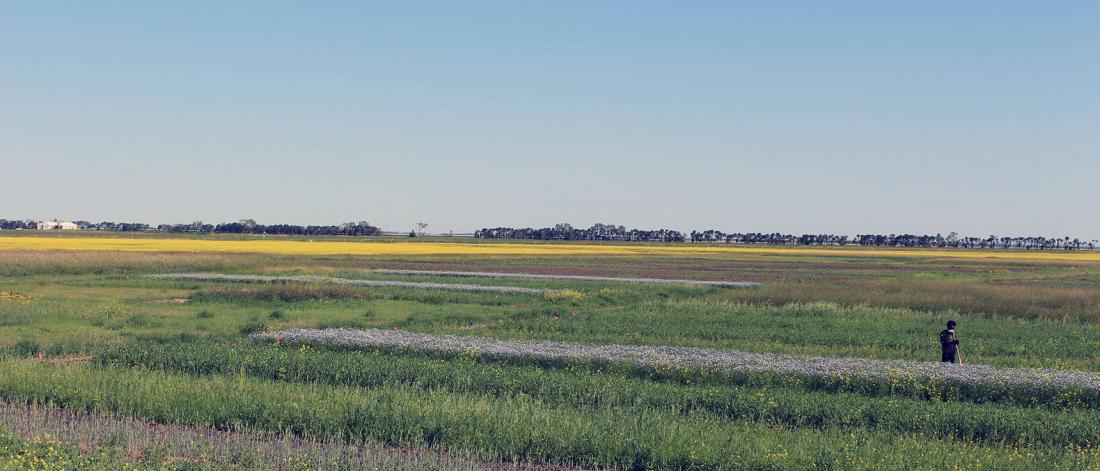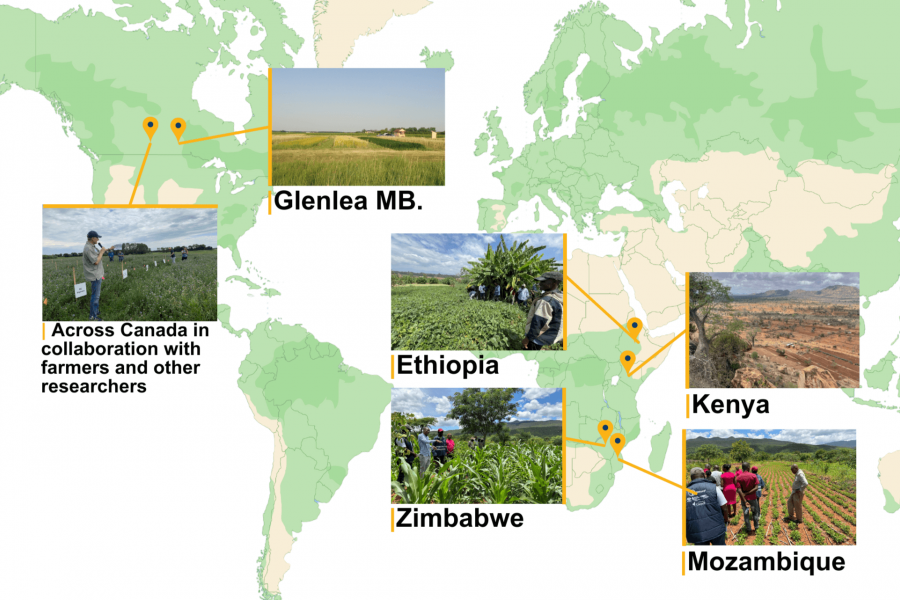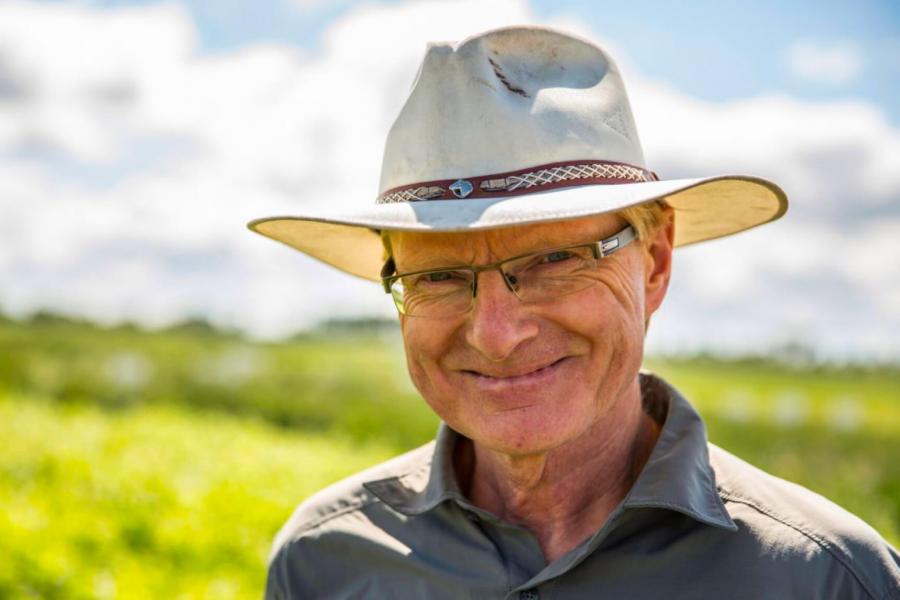Natural systems agriculture research group
We go beyond increasing the efficiency of current agricultural practices. Our goal is to redesign agricultural systems "so they function on a basis of ecology.” The group's research focuses include: long-term agroecological field studies; participatory organic crop production and crop breeding; integration of perennial plants and landscape diversity in production; crop-livestock integration; precision agroecology; and tropical conservation agriculture.

Current research projects
Canadian participatory plant breeding program
The Canadian participatory plant breeding program is a collaboration between farmers, plant breeders, and researchers along the breeding pipeline geared specifically for organic crop production. The main crops the PPB program focused on were wheat, oats, and potatoes. Principal activity took place between 2011 and 2020, with funding from the Canadian Organic Science Cluster II and III and the Bauta Family Initiative for Canadian Seed Security. Collaborating plant breeders were Dr. Stephen Fox (wheat), Dr. Jennifer Mitchell-Fetch (oat), Anne Kirk (wheat), Dr. Benoit Bizimungu (potato), and Dr. Duane Falk (potato). We are currently open to increasing wheat and oat seed for interested farmers, and incorporating the top performing wheat genotypes into the Glenlea long-term rotation trial.
We have also submitted top-performing genotypes to Dr. Malalgoda in Food Science to test the populations for the baking quality.
Lastly, we've created an 'evolutionary population' from the early generation wheat crosses in the original PPB program generated by UM. Ten farmers across Canada have received a small amount to start their own evolutionary population on their own farms!
Principle investigator: Dr. Michelle Carkner and Dr. Martin Entz
Funders: Jarislowsky Chair in Natural Systems Agriculture.
Controlled traffic farming with biological N supplied from traffic strip
The traditional method for supplying biological N to Prairie organic crops is to grow a green manure cover crop every 3rd or 4th year in the rotation. Here we also take 25% of arable land to produce biological N but use a different field geometry layout, one that may have additional co-benefits. This “proof of concept” project builds on the work of former MSc student, Matthew Wiens, who studied the role of mulch transfer in organic wheat production (Wiens, M.J., Entz, M.H., Martin, R.C. and Hammermeister, A.M., 2006. Agronomic benefits of alfalfa mulch applied to organically managed spring wheat. Can J Plant Sci 86:121-131). Here, we operationalize the system by growing crops between legume strips, then use the legume strips to supply N to the arable cropping system (see images below). In this way, ¼ of the field is used to produce N for arable crops, similar to traditional organic systems. The legume strip also serves as a zone for machinery traffic. This part of the project is still a work in progress as not all of our equipment is set up for the spacing. In future, we may have access to newer field equipment built specifically for controlled traffic farming in tilled systems (eg., the Nexat © System https://www.nexat.de/en/the-system/). We hypothesize that because the legume traffic zone consists
of perennial plants, compaction by machinery would be reduced. Further, the perennial strips can serve as snow trap barriers, provide erosion control, as well as habitat for beneficial insects.
Principle investigator: Dr. Martin Entz
Collaborators: TBD
Funders: The Jarislowsky Chair in Natural Systems Agriculture.
Crop response to organic amendments in a low phosphorus soil
Phosphorus (P) deficiency is one of the main challenges facing organic farms on the Canadian prairies. First part of this research investigates different organic soil amendments (cattle compost, anaerobic digestate, black soldier fly frass, and rabbit manure) as alternative sources of P for soybean planted in P-depleted soil under greenhouse conditions. The second part evaluates the effect of a long-term P mitigation strategy on P sufficiency and AMF infection in flax from Glenlea study. I am interested in testing whether manure addition improves plant performance in terms of P tissue concentration, P uptake, AMF, and biomass and if changes in AMF relate to plants P uptake.
Funder: NSERC, CREATE Climate-Smart Soil
Advisor: Dr. Martin Entz
Lead researcher: Laetitia Mukungu
Discovering moisture: the unknown potential of coleoptile length in wheat under dry seeding conditions
Longer coleoptiles are a valuable trait for winter and spring wheat varieties in dry conditions. Farmers in Manitoba have been experiencing dry spring and fall seeding conditions recently leading to poor stand establishment and therefore limited wheat yields. The objective of this study is to phenotype spring and winter wheat genotypes for coleoptile length and examine the influence this trait has on emergence speed under heavy and light soil texture when deep seeded.
Principle investigator: Dr. Michelle Carkner
Collaborators: Dr. Santosh Kumar (AAFC Brandon) and Dr. Curt McCartney (UM Plant Science)
Funders: Sustainable Canadian Agricultural Partnership (Manitoba Agriculture) and Manitoba Crop Alliance
Glenlea long-term organic vs conventional comparison study
The Glenlea study, located in Treaty 1 territory and in the heart of the Red River Metis nation, was started in 1992. Annual grain and forage-grain crop rotations are conducted under both organic and conventional management. Nutrient recycling subplots are included in selected organic treatments with nutrients from both livestock, insect and urban sources. A large grassland (native species) plot is included in each of the three replicates. This unique feature allows arable farming systems to be compared with nature’s agriculture– grassland – and helps set the stage for future “Nature-based” farming systems. Soil and plant/grain samples collected from the Glenlea study are archived each year and are available for future analysis by our research team or by collaborators. We welcome collaboration so please contact us anytime!
A word on the special role that long-term studies play: Dr. Henry Janzen, former curator of long-term field studies at Agriculture and AgriFood Canada, refers to long-term field studies as “listening places”. Perhaps Emerson said it best; “The years teach much the days never know” Ralph Waldo Emerson, 1844.
Principle investigator: Dr. Martin Entz
Current collaborators: Dr. Mario Tenuta (UM Soil Science); Dr. Xiaopeng Goa (UM Soil Science); Dr. Mervin St. Luce (Agriculture and AgriFood Canada, Swift Current); Dr. Tim Crews (Land Institute, Kansas).
Funders: Western Grains Research Foundation; the Organic Science Cluster; Agriculture and AgriFood Canada; the Prairie Oat Growers Association; Grain Millers; and the Jarislowsky Chair in Natural Systems Agriculture.
Legume Intensity + Livestock organic crop rotation trial
Organic crop rotations require legumes or a ‘green manure’ to fix enough nitrogen to supply the non-legume crops in the rotation (ex. Wheat, oats, flax). However, this often requires an expensive rotation phase, ex. An annual green manure (Thiessen Martens and Entz, 2011) or when hayed off leading to excess phosphorus export, ex. Perennial alfalfa (Carkner et al., 2020). However, there is potential for relay-cropped late season legumes to fix enough nitrogen for the following crop (Cicek et al., 2014), but has not been investigated in combination with intercropping practices.
The purpose of this study is to compare nitrogen supply (and other co-benefits of legume intensification) within an organic grain production system. The main question is whether legume intensification can maintain higher productivity and ecological services in organic grain production when combined with greater crop diversity.
Initiating in 2024, the trial compares two different organic rotation treatments: basic system and high diversity system in a 3 replicate, fully phased design:
| Basic system | High diversity system |
| Green manure plow-down (oat, pea, hairy vetch, subterranean clover) | Oat/pea grain intercrop, undersown hairy vetch and subterranean clover |
| Spring wheat | Spring wheat, relay cropped with red clover |
| Flax | Flax/lentil grain intercrop |
In 2025, we are incorporating sheep into the green manure (spring and fall grazing) and the wheat (red clover), pea-oat intercrop (fall grazing) to examine the impact of grazing on nutrient cycling.
Principle investigator: Dr. Michelle Carkner and Dr. Martin Entz
Researchers Involved: Sophia Partyka
Funders: Jarislowsky Chair in Natural Systems Agriculture.
Nature-based agriculture for climate resilience in East Africa
A large project directed by the Canadian Food Grains Bank is taking place across Ethiopia, Kenya, Zimbabwe and Mozambique with the goal to rehabilitate damaged landscapes through nature positive practices including conservation agriculture, natural regeneration, water retention, and reforestation. Our group has been tasked with multiple initiatives related to the project:
- Initiate on-the-ground research trials with a particular focus on nature-positive interventions and track the impact on farm-scale as well as surrounding landscape biodiversity and soil health.
- Monitoring the project with a particular eye to the ecosystem services provided by each landscape. The first aim of the GIS part of the project is a historical examination of land use and land change within each landscape over the last 30-40 years. Following this we intend to use current satellite data paired with on-ground biodiversity and soil health measurements, to pinpoint where practices are most effective.
- Supply research support and meaningful engagement with local partners
Principle investigators: Dr. Martin Entz, Dr. Sasha Loewen, and Dr. Michelle Carkner
Researchers involved: Andrew Enns, Laetitia Mukungu
Funder: Canadian Food Grains Bank
Organic Precision Thistle Tracking and Management in Manitoba
A project to harness the growing power and prevalence of drones and other remote sensing techniques in organic agriculture for weed tracking and management. Canadian thistle has long been one of organic grain system's greatest challenges in long term management. By using detailed aerial images and multi-spectral data we aim to provide quick, easy, and accurate weed maps to farmers to implement integrated weed management strategies of their choice. Of particular study interest is the use of precision seeding rates of cash and cover crops in heavy thistle areas to reduce the spread of thistle patches thereby reducing overuse of soil disturbing activities.
Principle investigator: Dr. Sasha Loewen
Collaborators: Dilshan Benaragama, Manitoba Organic Association, numerous organic farmers
Funder: Manitoba Organic Development Fund
LEAP Project
LEAP: Leveraging Ecosystems to transform Agriculture on the Prairies
More information on the LEAP project can be found on the LEAP Website
Principle Investigator: Dr. Martin Entz
Director of Research and Partnerships: Dr. Michelle Carkner
Funder: Natural Sciences and Engineering Research Council (NSERC)
Collaborators: University of Saskatchewan, Canadian Centre of Agricultural Wellbeing, Agriculture and Agri-Food Canada, Manitoba Agriculture, Keystone Agriculture Producers, National Farmers Union, Ducks Unlimited Canada, Nature United, Manitoba Beef Producers, Manitoba Forage and Grassland Association.
People
Where we work

Select publications
Participatory plant breeding
Carkner, M. K., and Entz, M. H. (2024). Determining adaptability of farmer bred spring wheat (Triticum aestivum L.) genotypes to Canadian organic production using stability analysis. Plant Breeding 143, 500–517.
Fetch, J. W. M., Entz, M., Fox, S. L., Spaner, D., Stanley, K., Carkner, M., Fetch, T. G., McCartney, C. A., Menzies, J. G., Wang, X., Ames, N., Nilsen, K. T., Burt, A., Kumar, S., Hamilton, K. D., Green, D. A., Dyck, W., Stewart, K., & Cormack, B. (2022). AAC Kongsore oat. Canadian Journal of Plant Science, 102(6), 1225–1231.
Crop-livestock integration
Organic agronomy
Glenlea long term organic rotation study
No-till organic
Cover crops
Sustainable agriculture in East and Southern Africa
Lab philosophy
Our inspiration
Each member of the Natural Systems Agriculture team, including our associates and supporters, bring their own story to the work. We are all shaped by our family history, our social circumstances and experiences, and the place we call home. We have gained our inspiration from many different places and many different people; it is impossible to list them all.
The Land Institute in Salinas, Kansas developed the idea of natural systems agriculture idea in 1977. Land Institute founder, Wes Jackson, argued “most of our current efforts to make agriculture more sustainable focus on accumulating the best from tradition, but natural systems agriculture is profoundly different”. A primary feature is to “sufficiently mimic the natural structure to be granted the function of its components” (Jackson 2002).
We are also inspired by Sir Albert Howard’s recognition that farmers in India were his teachers. In his writings (eg., An Agricultural Testament, 1948) Sir Albert referred to Indian farmers as “my professors”. One of Albert Howard’s colleagues, Lady Eve Balfour inspired us to establish a long-term study where different nature-based farming systems are compared. In fact, Lady Eve’s Haughley experiment, established in 1926, was the first organic vs conventional agriculture study in the world.
Indigenous peoples practiced agriculture on the shores of Manitoba’s Red River 600 years ago. We are inspired to learn more about these early agricultural systems and the people who practiced them. We are also inspired to engage in reconciliation with Indigenous peoples as we recognize that colonization destroyed Indigenous agriculture in our country.
The Principles
The University of Manitoba Natural Systems Agriculture program, led by Martin Entz, Jarislowsky Chair holder in Natural Systems Agriculture for Climate Solutions, follows the principles laid out by Wes Jackson and colleagues in “Agriculture as a mimic of natural ecosystems” (Lefroy et al. 1999). The principles are as follows: 1) humans are part of the system; 2) a common currency is required and energy can serve this purpose; 3) energy flow in natural systems is self-regulated through mutualistic processes which have evolved to be more efficient than today’s fossil-fuel based agriculture; and 4) the stability and sustainability of all systems may be enhanced by maintaining species and landscape biodiversity (Entz and Van Die, 2024).
We also follow the teachings of Agroecologist, Steven Gliessman. He argues that while increasing efficiency of inputs is a first step to improving the sustainability of agriculture, whole system change is required. “We must Redesign the system so that it functions on basis of a new set of ecological relationships.”
Finally, we believe that despite the cost of the transition to natural systems agriculture, there is an urgent need to proceed. We recognize that change is hard and take heart in the words of Stan Rowe, author of “Home place” who stated “We naturally suppose having grown up with this particular farming system, that it will go on, forever”.
The Practices
Historical Ecological Analysis
Indigenous cultures in Canada and ancient farmers around the world employed practices based on “nature’s wisdom”. Our team engages in understanding and analyzing these historical ecological practices. For example, water resources in the dryland Prairies were protected by conserving populations of beaver (Castor canadensis), which maintained water levels in the valleys shared by humans and bison; an example of advanced resource stewardship (Berkes, 2018). In the 19th century, European demand for beaver pelts resulted in an increase in beaver hunting, and so this traditional conservation practice for drought mitigation was lost.
Perenniality
Perenniality can be accomplished by preserving and enhancing remaining grassland, by including perennial forage and tree crops in rotations, growing perennial grains such as Kernza Intermediate Wheatgrass, and “perennializing” annual grain-based cropping systems through the use of cover crops.
Diversity
Natural systems agricultural systems must emphasize field and landscape biodiversity. This means intense use of crop rotation, cover cropping, etc. It also means expanding the trophic diversity in the food system with emphasis on more efficient animal species (eg., rabbits), and new processes such as aquaculture and insect agriculture.
Livestock Integration
Sir Albert Howard claimed that “Mother earth never attempts to farm without livestock”. Crop-livestock integration turns the problems of overspecialized crop production and overspecialized livestock production into a solution (Clark and Poincelet).
Recycling
Recycling not only involves using cattle and other livestock manure to nourish crops. It must also involve anthronutrients, nutrients from human sources. This will allow us to recycle nutrients from urban areas back to agriculture.
Participatory Methods
Our team engages farmers and land managers in the research process. In Canada, we have engaged grain farmers in wheat and oat breeding since 2011 (Carkner et al. 2024). In East Africa, we have used the tacit knowledge of local farmers to document soil health improvements owing to various soil conservation practices (Entz et al. 2022).







